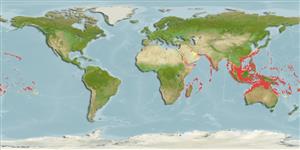分类 / Names
俗名 | 同种异名 | Catalog of Fishes(属, 种) | ITIS | CoL | WoRMS | Cloffa
Teleostei >
Eupercaria/misc (Various families in series Eupercaria) >
Lutjanidae (Snappers) > Apsilinae
Etymology: Paracaesio: Greek, para = the side of + Latin, caesium = bluish grey (Ref. 45335).
Environment: milieu / climate zone / depth range / distribution range
生态学
海洋 礁区鱼类; 深度上下限 5 - 200 m (Ref. 9821), usually ? - 100 m (Ref. 9710). 熱帶; 32°N - 30°S, 32°E - 127°W
Indo-Pacific: Red Sea and East Africa to the Marquesas and Pitcairn, north to the Ryukyu Islands.
印度-太平洋: 阿卡巴灣而且東非到馬可薩斯島與皮特凱恩島, 北至琉球群島。
大小 / 重量 / 年龄
Maturity: Lm ? range ? - ? cm
Max length : 48.0 cm TL 雄鱼/尚未辨别雌雄; (Ref. 9710); common length : 27.5 cm SL 雄鱼/尚未辨别雌雄; (Ref. 37816)
背棘 (总数) : 10; 背的软条 (总数) : 9 - 10; 臀棘: 3; 臀鳍软条: 8.
眼大的; 吻短, 大约等于, 或短于眼直径。 眼间隔凸状。 上颌与下颌大约相等。 颚骨没有鳞片。 胸鳍长的, 达到肛门高度。 鳞片列背面平行于侧线。 全体深紫褐色到蓝色的; 银色或微白色的在下侧与腹面上; 背鳍与尾鳍鳍褐色的到些微淡黄色, 另一个鳍微白色的到半透明的。 稚鱼有一个黄色到橘色的尾鳍。 (参考文献 48635)
Adults are found over rocky bottoms often in schools. They feed on plankton (Ref. 9710, 48635). Usually marketed fresh.
生活在岩石底部之上。 成群出现。 吃浮游生物。 (参考文献 9710,48635) 通常生鲜地在市场上销售。
Life cycle and mating behavior
成熟度 | 繁殖 | 产卵场 | 卵 | 孕卵数 | 仔鱼
印度-太平洋: 阿卡巴灣而且東非到馬可薩斯島與皮特凱恩島, 北至琉球群島。
Anderson, W.D. Jr. and G.R. Allen, 2001. Lutjanidae. Jobfishes. p. 2840-2918. In K.E. Carpenter and V. Niem (eds.) FAO species identification guide for fishery purposes. The living marine resources of the Western Central Pacific. Vol. 5. Bony fishes part 3 (Menidae to Pomacentridae). FAO, Rome. (Ref. 9821)
世界自然保护联盟红皮书 (Ref. 130435: Version 2024-1)
人类利用
渔业: 商业性; 游钓鱼种: 是的
工具
特别资料
下载 XML
网络资源
Estimates based on models
Preferred temperature (Ref.
123201): 21.8 - 28.4, mean 26.9 °C (based on 1267 cells).
Phylogenetic diversity index (Ref.
82804): PD
50 = 0.5039 [Uniqueness, from 0.5 = low to 2.0 = high].
Bayesian length-weight: a=0.01622 (0.00918 - 0.02864), b=3.07 (2.91 - 3.23), in cm total length, based on LWR estimates for this species & (Sub)family-body (Ref.
93245).
营养阶层 (Ref.
69278): 2.8 ±0.31 se; based on food items.
回复力 (Ref.
120179): 中等的, 族群倍增时间最少 1.4 - 4.4年 (Preliminary K or Fecundity.).
Fishing Vulnerability (Ref.
59153): Moderate vulnerability (38 of 100).
Nutrients (Ref.
124155): Calcium = 37.2 [22.4, 73.2] mg/100g; Iron = 0.649 [0.334, 1.103] mg/100g; Protein = 18.4 [16.4, 20.1] %; Omega3 = 0.139 [0.085, 0.235] g/100g; Selenium = 46 [26, 89] μg/100g; VitaminA = 97.7 [30.0, 352.1] μg/100g; Zinc = 1.16 [0.79, 1.63] mg/100g (wet weight);
